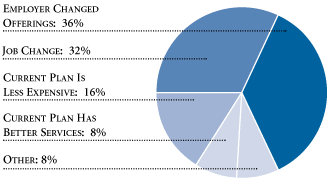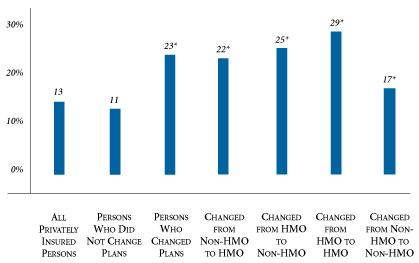
Who Is Likely to Switch Health Plans?
Data Bulletin No. 18
July 2000
Peter J. Cunningham, Linda T. Kohn
![]() ne out of six consumers with private health
insurance changed plans over a one-year period between 1996-1997, according to recent
Household Survey findings from the Center for Studying Health System Change (HSC). Most
people who changed plans did so for reasons other than personal preference. More than
two-thirds did so either because they changed jobs or their employers changed plan
offerings (see Figure 1). Fewer than one-quarter changed to their
current plan because it is less costly or offers better services.
ne out of six consumers with private health
insurance changed plans over a one-year period between 1996-1997, according to recent
Household Survey findings from the Center for Studying Health System Change (HSC). Most
people who changed plans did so for reasons other than personal preference. More than
two-thirds did so either because they changed jobs or their employers changed plan
offerings (see Figure 1). Fewer than one-quarter changed to their
current plan because it is less costly or offers better services.
FIGURE 1
REASONS FOR CHANGING HEALTH PLANS

Note: Sample includes only people continuously insured through private sources.
Source: Community Tracking Study Household Survey, 1996-1997
Switching between Types of Plans
Overall, more people switched into a health maintenance organization (HMO) than into a more traditional plan-consistent with overall trends in plan mix at the time. Nearly one-quarter of people who switched plans moved from a non-HMO to an HMO, and 11 percent moved the other way-from an HMO to a non-HMO. Those who switched to an HMO were more likely than others who changed plans to cite costs as the reason. Despite the consumer backlash against managed care plans, those who left HMOs were no more likely than other plan changers to cite better services in their new plan as the reason for switching.
Demographic Factors
The near-elderly (people ages 55 to 64), African Americans, Hispanics and persons in fair or poor health-vulnerable populations that are at risk for having difficulty getting access to care-were less likely than others to change health plans (see Figure 2). This was also true for persons with less education.
When African Americans or those in fair or poor health do change plans, however, they are more likely to switch to an HMO. Previous HSC research found that African Americans expressed greater willingness than whites to give up some choice to save on costs, which is consistent with their greater likelihood of switching to an HMO. Persons with more serious health problems (who tend to have higher-than-average health care costs) who switch plans may prefer HMOs to save money. These results suggest that HMO favorable selection practices, to the extent that they exist, are not necessarily a barrier to everyone with serious health problems.
FIGURE 2 |
|
ALL PRIVATELY INSURED PERSONS |
PERCENT WITH ANY CHANGE IN PLANS |
| AGE | |
| 0-18 | 16% |
| 19-34 | 22* |
| 35-44 | 17 |
| 45-54 | 15* |
| 55-64 | 11* |
| RACE/ETHNICITY | |
| WHITE | 18% |
| BLACK | 14* |
| HISPANIC | 13* |
| OTHER | 17 |
| HEALTH STATUS | |
| EXCELLENT | 18% |
| VERY GOOD | 17 |
| GOOD | 15* |
| FAIR OR POOR | 13* |
| * Difference from comparison group (shown in italics) is
statistically significant at p<.05 level. Note: Sample includes all persons continuously insured through private insurance. Source: Community Tracking Study Household Survey,1996-1997 |
|
Effect on Source of Care
Twenty-three percent of those who changed health plans also changed their usual source of care, whether a doctor, nurse or other health professional or a specific place other than a hospital emergency room (see Figure 3). The rate of provider switching was somewhat higher-29 percent-for those switching between two HMOs.
Given that most people who change plans keep their usual source of care suggests that there is considerable overlap among provider networks. Another reason may be that people are choosing to pay higher copayments-or even the full costs of medical visits-for going outside the network to see a doctor with whom they have a long-standing relationship.
FIGURE 3
PRIVATELY INSURED PERSONS WHO CHANGED THEIR USUAL SOURCE OF CARE

Implications
Most plan changes are involuntary. Yet, very few privately insured persons (2 percent) are forced to change providers as a result of a change in health plans, and it is likely that this will not increase given the various patients’ bills of rights that call for greater provider continuity and access. However, a return to high annual increases in health insurance premiums could lead to greater demand for lower-cost plans and tighter networks, which could result in more plan and provider switching.
This Data Bulletin presents findings from the 1996-1997 Household Survey, a nationally representative telephone survey of the civilian, noninstitutionalized population conducted as part of the Community Tracking Study. The 1996-1997 survey includes nearly 33,000 families and 60,000 individuals. The Data Bulletin is adapted from "Health Plan Switching: Choice or Circumstance?" by Peter J. Cunningham and Linda Kohn, Health Affairs, Vol. 19, No. 3 (May/June 2000). This study includes 37,545 persons who were privately insured throughout the year.